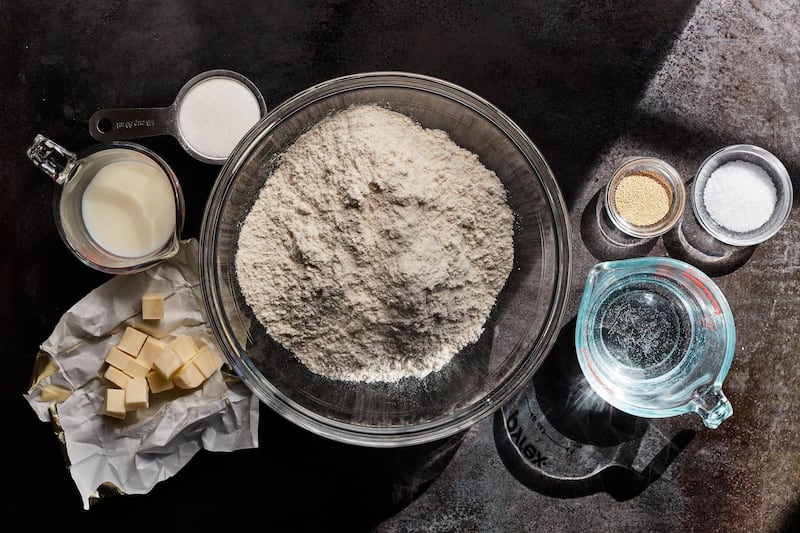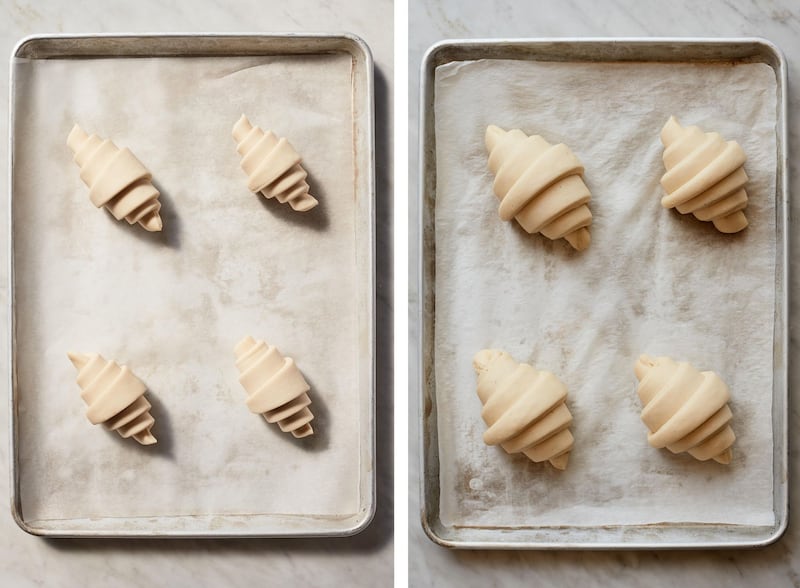Does anything in the baking realm rival a fresh croissant, the way its burnished shell shatters, then yields to the silky, bready, layered interior? Simply, the answer is no. A pastry as miraculous as a croissant is, predictably, tricky to make at home. There is the lamination – the process of rolling and flattening butter into thin sheets between layers of dough – and the rolling and folding of that butter-layered dough, a technique called a “turn.” In professional settings, machines called slab rollers in temperature-controlled rooms laminate the dough quickly and effectively, producing light, flaky, uniform croissants. Home bakers, however, must complete these tasks by hand, making it harder, slower and much more variable.

It’s a lot to take on, but none of that should dissuade you from trying. Anyone with even a passing interest in baking will feel pure elation upon pulling a baking sheet of puffed, burnished crescents from the oven. Once you master the basic dough, you can expand your skills, adding fillings like chocolate or ham and cheese, or even repurposing leftover plain croissants as almond croissants. Getting to that point requires following a tight script, but many of the factors that determine success can be controlled in a home kitchen through some key techniques. And below are even more tips to help guide you smoothly and confidently through the process.
MIND YOUR INGREDIENTS

Look to high-protein flour A flour with an 11 per cent to 13 per cent protein content (often noted on the bag) is necessary for a sturdy, gluten-rich dough that can support many layers of butter and withstand the rolling and folding required to create those layers. Strong white flour will work – and if you spot some French pastry or patisserie flour (look out, too, for type 55 French flour), so much the better.
Pay attention to your yeast Experienced bakers generally prefer to use fresh yeast when making croissants, as it's more reliable than active dry yeast. However, active dry yeast is by far easiest for home bakers to find. You want to be confident that your fresh yeast is alive, so keep it refrigerated and make sure it's being used well before the expiration date. (If you have doubts, you may want to proof it: warm 120g of the total milk in the accompanying base recipe to about 105 degrees, then combine it in a small bowl with the 7g active dry yeast and stir until dissolved. Let it sit until the mixture is foamy, about 5 minutes, then proceed.)
Spring for the good butter Irish and other European butter contains at least 82 per cent butterfat by weight. This high fat content makes it rich in flavour and more "plastic", or able to bend while cold without breaking. This relative flexibility will help the butter roll out more easily, eventually resulting in lighter, taller croissants with defined layers. Of all the butters I tested, I liked Kerrygold the best, because it maintains a waxy, malleable texture even when cold, so the butter block resists cracking and splitting apart inside the dough during rolling.
SET YOURSELF UP FOR SUCCESS
Clear your schedule and prepare your space Be sure to budget two days for this project, with most of the active work taking place on the first day. Make every effort to avoid working in a hot kitchen (20 to 22 degrees is about right), which will make rolling out the butter-laden dough and controlling fermentation much easier. Clear off several feet of counter space. Make room in the refrigerator, as well as room in the freezer for the dough. It's important that the dough stay as cold as possible throughout the process, so minimise opening and closing the fridge and freezer doors.
... and your ingredients Weigh all your ingredients for the dough (also called the detrempe), especially the flour, water and milk. The specific ratio of liquid to flour in the accompanying base recipe, called the "hydration", produces a dough that's the right texture for croissants – soft enough to roll out by hand yet firm enough to keep the butter enclosed.
NAIL THE PROCESS
Keep your edges sharp... One of the most important factors in making bakery-quality croissants at home is also the trickiest: maintaining the dough's squared-off edges and straight sides throughout the lamination process. What might seem like a minor issue early on – a lopsided butter block, for example – can compound down the line, so attention to detail is important. Sharp corners and straight sides help the dough align with itself as it's folded during each turn, ensuring the croissants have the same number of layers and are a similar size. It's a skill that takes practice, so understand that you might have difficulty on your first several tries, but, as long as you follow the other principles outlined here, a little unevenness or misalignment won't ruin your croissants.
...your dough cold... How well you control fermentation also largely determines your success. You'll want to keep the dough as cold as possible to prevent the yeast from producing gases during lamination, but not so cold that the butter becomes too hard to roll out smoothly between the layers. Whenever the dough is out, try to work quickly to prevent it from warming and fermenting.
...and your cuts clean For the most defined croissants, use a wheel cutter (either a pastry wheel or a pizza cutter) when cutting your dough. It slices cleanly, with minimal dragging or tearing. If you don't have a wheel cutter, a sharp knife will suffice, or you can use a clean Stanley knife.

Look for proof Sufficiently proving croissants so they achieve maximum lightness takes patience and practice. It's easy to undershoot. Poking the dough, the normal test a baker would use, isn't an option, because the risen dough is too delicate and will tear, disrupting the layers. The best indicators are visual: the dough will be so filled with gases from the yeast that the layers along the cut sides will have separated, and the surfaces will be rounded and very puffed – like little crescent-shaped Michelin men. When you gently shake the baking sheet, a proved croissant will have a subtle wobble.
Apply the egg wash carefully A combination of egg yolk and double cream produces a glossy, bronzed outside. While applying it, take care to avoid coating the exposed layers on the cut sides of the dough, as this will fuse them together. If you have lots of egg drips on the baking sheet, wipe them off, as these could burn while baking. Chilling the croissants uncovered while the oven heats helps firm them up so it's easier to apply the egg wash, and dries out the surface of the dough, leading to a well-developed exterior.
Is making croissants at home an easy feat? Not in the least. But is it a fascinating and fun project? Certainly, even if you encounter some hiccups along the way. Know that the more times you make them, the better your croissants will turn out, but even a first attempt – provided you follow the suggestions and principles outlined here – will most likely produce a breathtaking, delicious result. – New York Times
Recipe: Croissants
Recipe: Pain au chocolat
Recipe: Ham and cheese croissants
Recipe: Almond croissants














